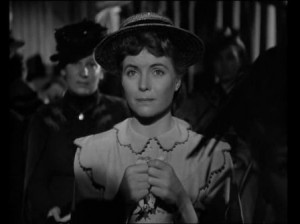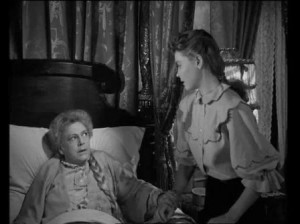“I’m never more witty than when I’ve had a little nip. I see better, I hear better and I feel much better. . . . I’d keep a much better eye on Helen if I had a little nip.” — Mrs. Oates
No, the staircase of the title is not the wide, straight staircase in the living room of the Warren house, but the staircase—yes, spiral in design, with a thin, metal railing—that descends to the basement of that house, to the dark, cluttered basement where a candle is a must. And, who knows, where someone might be watching while, say, a maid is searching for a bottle of wine.
The Spiral Staircase (1946) begins at a hotel. Judging by the cars in the opening shot of the town and the attire of the people, this is the 1920s, and so the film being shown on the first floor is a silent one, The Kiss—an actual film starring Greta Garbo and Conrad Nagel. The pianist, accompanying the screen, has played a bit of a Chopin waltz and then some clichéd theater music of her trade before she excerpts Beethoven’s “Appassionato” Sonata.
As the audience enjoys the film, the camera tilts to the ceiling. In the upstairs Room No. 9, a young woman (Myrna Dell) limps to her clothes closet, and Roy Webb’s orchestral score takes up the dark Beethoven. The clothes hangers in the closet move, and a large, leering eye and the eerie, quavering sound of the theremin fill the screen. It’s actually director Robert Siodmak’s eye, and the electronic theremin was introduced by Miklós Rózsa in Spellbound and The Lost Weekend, both released the year before. The young woman slips a nightgown over her shoulders, and the arms she lifts above her head abruptly stiffen and her fingers become spastic, impotent claws.
 The impressive stars of the film, made by RKO, recreate some diverse characters, not many of them likable. Helen (Dorothy McGuire), also watching the film, is a young girl who has been unable to speak since witnessing years ago her parents’ death in a fire. She is employed—it’s never clear what she does—in the Warren household, the home of Professor Albert Warren (George Brent, whose string of Bette Davis films—Jezebel, Dark Victory, The Old Maid, The Great Lie, In This Our Life, etc.—had recently ended).
The impressive stars of the film, made by RKO, recreate some diverse characters, not many of them likable. Helen (Dorothy McGuire), also watching the film, is a young girl who has been unable to speak since witnessing years ago her parents’ death in a fire. She is employed—it’s never clear what she does—in the Warren household, the home of Professor Albert Warren (George Brent, whose string of Bette Davis films—Jezebel, Dark Victory, The Old Maid, The Great Lie, In This Our Life, etc.—had recently ended).
Also living in the house are the professor’s invalid and cantankerous mother (Ethel Barrymore), the maid/cook Mrs. Oates (Elsa Lanchester), her husband (Rhys Williams) and Albert’s womanizing stepbrother Steven (Gordon Oliver). There are also Albert’s secretary Blanche (Rhonda Fleming), pursued by Steven, and Mrs. Warren’s abrasive nurse (Sara Allgood). Dropping in from time to time are Doctor Parry (Kent Smith), who attends Mrs. Warren and courts Helen, and the constable (James Bell).
 Seen only once in the opening scenes, uncredited, are Ellen Corby, Esther in the TV series The Waltons, and Erville Alderson, who did many bits as historical figures: Jefferson Davis in Santa Fe Trail, Stonewall Jackson in Abe Lincoln in Illinois and General Joseph Stilwell in Objective, Burma!
Seen only once in the opening scenes, uncredited, are Ellen Corby, Esther in the TV series The Waltons, and Erville Alderson, who did many bits as historical figures: Jefferson Davis in Santa Fe Trail, Stonewall Jackson in Abe Lincoln in Illinois and General Joseph Stilwell in Objective, Burma!
So—a lot of suspects loose in an isolated house plagued by, seemingly, constant thunderstorms, of which script, camera and score make the most. One of the best thrillers/mysteries of the era. Leslie Halliwell called The Spiral Staircase “a superior ‘thunderstorm mystery,’ ” far superior to the pathetic 1975 British remake with Jacqueline Bisset and Christopher Plummer, where the intrusion of color ruins things from the beginning. “Best forgotten,” Halliwell says. What, now, is that general rule regarding remakes?!——
The milieu of the Warren dwelling and the thunderstorms recalls The Old Dark House from 1932, And Then There Were None, the Hitchcock Psycho and many others, even such a trifle as Bob Hope’s The Ghost Breakers.
Besides the hotel murder, there are further, early evocations of the sinister and unexpected. In Helen’s walk home through the woods Webb’s score gradually shifts from gentle forest murmurs to dark premonitions. There’s that unnerving sound as she runs a stick along an iron fence, much as a policeman does in the 1944 Gaslight, and, lurking in the rain among the trees, the back of a raincoat-clad figure.
The constable had hit it on the head about the murder in Room No. 9, and Mrs. Oates has seen the pattern, too: “First the girl with the scar on her face, then that simple-minded one and, now, the cripple in the hotel. Seems like—” She doesn’t finish. The constable finishes her thought in one of his visits to Professor Warren, as if, he said, all the victims were targeted because of their physical defects.

One thought to “The Spiral Staircase (1946)”